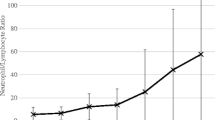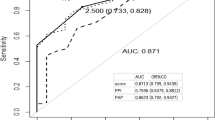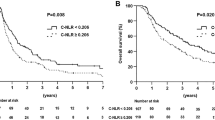Abstract
Purpose
We aimed to investigate the prognostic factors that can predict terminal stage survival (TSS) at the time of terminal cancer diagnosis.
Methods
We prospectively evaluated 141 patients immediately after the diagnosis of terminal cancer by their attending oncologists. A total of 32 factors, including performance status, clinical prediction of survival, time to terminal cancer (TTC), clinical symptoms, signs, and laboratory tests including the neutrophil–lymphocyte ratio (NLR), were analyzed. TSS was defined as the time from the diagnosis of terminal cancer to death.
Results
The mean age of the 141 patients studied was 58.7 years, and 53 were female (38 %). The median TSS was 1.7 months (95 % confidence interval [CI] 1.43–1.97). In the univariate analyses, the TSS was significantly associated with 16 of the 32 factors tested. In the multivariate analysis, a lower Karnofsky performance status (KPS), a shorter TTC (<24 months), a high NLR (≥5), and a high C-reactive protein (CRP) level (≥10 mg/dL) were independently associated with a poorer prognosis. A scoring system (scale, 0–6) developed based on the multivariate analysis could be used to classify terminal cancer patients into better (0–2 points; TSS 3.9 months), intermediate (3–4 points; TSS 1.7 months), or worse (5–6 points; TSS 0.9 month, P < 0.001) prognosis.
Conclusion
The median TSS after the diagnosis of terminal cancer in advanced cancer patients was 1.7 months. The scoring system using KPS, TTC, NLR, and CRP could predict TSS in these patients.


Similar content being viewed by others
References
Aabom B, Kragstrup J, Vondeling H, Bakketeig LS, Stovring H (2005) Defining cancer patients as being in the terminal phase: who receives a formal diagnosis, and what are the effects? J Clin Oncol 23(30):7411–7416
Baile WF, Buckman R, Lenzi R, Glober G, Beale EA, Kudelka AP (2000) SPIKES-A six-step protocol for delivering bad news: application to the patient with cancer. Oncologist 5(4):302–311
Chow E, Abdolell M, Panzarella T, Harris K, Bezjak A, Warde P, Tannock I (2008) Predictive model for survival in patients with advanced cancer. J Clin Oncol 26(36):5863–5869
Christakis NA, Lamont EB (2000) Extent and determinants of error in doctors’ prognoses in terminally ill patients: prospective cohort study. BMJ 320(7233):469–472
Chuang RB, Hu WY, Chiu TY, Chen CY (2004) Prediction of survival in terminal cancer patients in Taiwan: constructing a prognostic scale. J Pain Symptom Manage 28(2):115–122
Earle CC, Neville BA, Landrum MB, Ayanian JZ, Block SD, Weeks JC (2004) Trends in the aggressiveness of cancer care near the end of life. J Clin Oncol 22(2):315–321
Feliu J, Jiménez-Gordo AM, Madero R, Rodríguez-Aizcorbe JR, Espinosa E, Castro J, Acedo JD, Martínez B, Alonso-Babarro A, Molina R, Cámara JC, García-Paredes ML, González-Barón M (2011) Development and validation of a prognostic nomogram for terminally ill cancer patients. J Natl Cancer Inst 103(21):1613–1620
Gabay C, Kushner I (1999) Acute-phase proteins and other systemic responses to inflammation. N Engl J Med 340(6):448–454
Glare PA, Eychmueller S, McMahon P (2004) Diagnostic accuracy of the palliative prognostic score in hospitalized patients with advanced cancer. J Clin Oncol 22(23):4823–4828
Glare P, Sinclair C, Downing M, Stone P, Maltoni M, Vigano A (2008) Predicting survival in patients with advanced disease. Eur J Cancer 44(8):1146–1156
Guthrie GJ, Charles KA, Roxburgh CS, Horgan PG, McMillan DC, Clarke SJ (2013) The systemic inflammation-based neutrophil-lymphocyte ratio: experience in patients with cancer. Crit Rev Oncol Hematol 88(1):218–230
Gwilliam B, Keeley V, Todd C, Gittins M, Roberts C, Kelly L, Barclay S, Stone PC (2011) Development of prognosis in palliative care study (PiPS) predictor models to improve prognostication in advanced cancer: prospective cohort study. BMJ 343:d4920
Harrell FE Jr, Lee KL, Mark DB (1996) Multivariable prognostic models: issues in developing models, evaluating assumptions and adequacy, and measuring and reducing errors. Stat Med 15(4):361–387
Hui D, Mori M, Parsons HA, Kim SH, Li Z, Damani S, Bruera E (2012) The lack of standard definitions in the supportive and palliative oncology literature. J Pain Symptom Manage 43(3):582–592
Hyodo I, Morita T, Adachi I, Shima Y, Yoshizawa A, Hiraga K (2010) Development of a predicting tool for survival of terminally ill cancer patients. Jpn J Clin Oncol 40(5):442–448
Krishnan M, Temel JS, Wright AA, Bernacki R, Selvaggi K, Balboni T (2013) Predicting life expectancy in patients with advanced incurable cancer: a review. J Support Oncol 11(2):68–74
Lingjun Z, Jing C, Jian L, Wee B, Jijun Z (2009) Prediction of survival time in advanced cancer: a prognostic scale for Chinese patients. J Pain Symptom Manage 38(4):578–586
Mack JW, Cronin A, Keating NL, Taback N, Huskamp HA, Malin JL, Earle CC, Weeks JC (2012) Associations between end-of-life discussion characteristics and care received near death: a prospective cohort study. J Clin Oncol 30(35):4387–4395
Maltoni M, Caraceni A, Brunelli C, Broeckaert B, Christakis N, Eychmueller S, Glare P, Nabal M, Viganò A, Larkin P, De Conno F, Hanks G, Kaasa S (2005) Prognostic factors in advanced cancer patients: evidence-based clinical recommendations—a study by the Steering Committee of the European Association for Palliative Care. J Clin Oncol 23(25):6240–6248
Martin L, Watanabe S, Fainsinger R, Lau F, Ghosh S, Quan H, Atkins M, Fassbender K, Downing GM, Baracos V (2010) Prognostic factors in patients with advanced cancer: use of the patient-generated subjective global assessment in survival prediction. J Clin Oncol 28(28):4376–4383
Matsuyama R, Reddy S, Smith TJ (2006) Why do patients choose chemotherapy near the end of life? A review of the perspective of those facing death from cancer. J Clin Oncol 24(21):3490–3496
McMillan DC (2008) An inflammation-based prognostic score and its role in the nutrition-based management of pateints with cancer. Proc Nutr Soc 67:257–262
Morita T, Tsunoda J, Inoue S, Chihara S (1999) The Palliative Prognostic Index: a scoring system for survival prediction of terminally ill cancer patients. Supp Care Cancer 7(3):128–133
Pirovano M, Maltoni M, Nanni O, Marinari M, Indelli M, Zaninetta G, Petrella V, Barni S, Zecca E, Scarpi E, Labianca R, Amadori D, Luporini G (1999) A new palliative prognostic score: a first step for the staging of terminally ill cancer patients. Italian Multicenter and Study Group on Palliative Care. J Pain Symptom Manage 17(4):231–239
Steinhauser KE, Christakis NA, Clipp EC, McNeilly M, Grambow S, Parker J, Tulsky JA (2001) Preparing for the end of life: preferences of patients, families, physicians, and other care providers. J Pain Symptom Manage 22(3):727–737
Steyerberg EW, Harrell FE Jr, Borsboom GJ, Eijkemans MJ, Vergouwe Y, Habbema JD (2001) Internal validation of predictive models: efficiency of some procedures for logistic regression analysis. J Clin Epidemiol 54(8):774–781
Stone PC, Lund S (2006) Predicting prognosis in patients with advanced cancer. Ann Oncol 18(6):971–976
Suh SY, Ahn HY (2007) A prospective study on C-reactive protein as a prognostic factor for survival time of terminally ill cancer patients. Supp Care Cancer 15(6):613–620
Suh SY, Choi YS, Shim JY, Kim YS, Yeom CH, Kim D, Park SA, Kim S, Seo JY, Kim SH, Kim D, Choi SE, Ahn HY (2010) Construction of a new, objective prognostic score for terminally ill cancer patients: a multicenter study. Supp Care Cancer 18(2):151–157
Vigano A, Donaldson N, Higginson IJ, Bruera E, Mahmud S, Suarez-Almazor M (2004) Quality of life and survival prediction in terminal cancer patients: a multicenter study. Cancer 101(5):1090–1098
Yun YH, Heo DS, Heo BY, Yoo TW, Bae JM, Ahn SH (2001) Development of terminal cancer prognostic score as an index in terminally ill cancer patients. Oncol Rep 8(4):795–800
Yun YH, Kwon YC, Lee MK, Lee WJ, Jung KH, Do YR, Kim S, Heo DS, Choi JS, Park SY (2010) Experiences and attitudes of patients with terminal cancer and their family caregivers toward the disclosure of terminal illness. J Clin Oncol 28(11):1950–1957
Yun YH, Lee MK, Kim SY, Lee WJ, Jung KH, Do YR, Kim S, Heo DS, Choi JS, Park SY, Jeong HS, Kang JH, Kim SY, Ro J, Lee JL, Park SR, Park S (2011) Impact of awareness of terminal illness and use of palliative care or intensive care unit on the survival of terminally ill patients with cancer: prospective cohort study. J Clin Oncol 29(18):2474–2480
Acknowledgments
We are grateful to Soo Hee Kang and the Medical Research Collaborating Center of Seoul National University Hospital for supporting the statistical analysis of this study. This study was supported by grant number 11-2009-036 from the SNUBH Research Fund, Republic of Korea.
Conflict of interest
We certify that there is no conflict of interest with any financial organization regarding the material discussed in the manuscript.
Author information
Authors and Affiliations
Corresponding author
Rights and permissions
About this article
Cite this article
Kim, Y.J., Kim, SJ., Lee, J.K. et al. Prediction of survival in terminally ill cancer patients at the time of terminal cancer diagnosis. J Cancer Res Clin Oncol 140, 1567–1574 (2014). https://doi.org/10.1007/s00432-014-1688-1
Received:
Accepted:
Published:
Issue Date:
DOI: https://doi.org/10.1007/s00432-014-1688-1




